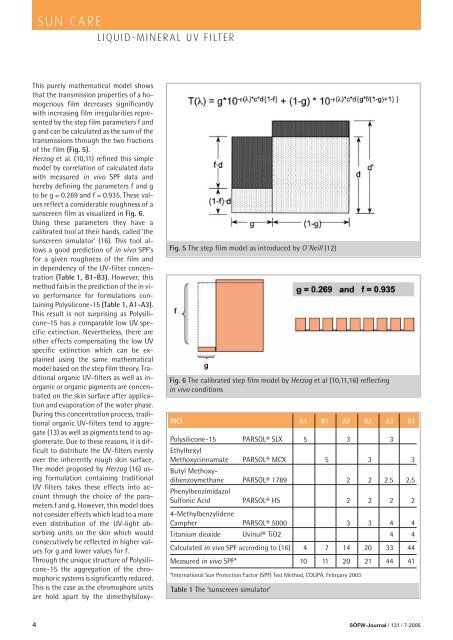Formulating High SPF Sun Care Products With A - External Factor ...
Formulating High SPF Sun Care Products With A - External Factor ...
Formulating High SPF Sun Care Products With A - External Factor ...
You also want an ePaper? Increase the reach of your titles
YUMPU automatically turns print PDFs into web optimized ePapers that Google loves.
SUN CARE<br />
LIQUID-MINERAL UV FILTER<br />
This purely mathematical model shows<br />
that the transmission properties of a homogenous<br />
film decreases significantly<br />
with increasing film irregularities represented<br />
by the step film parameters f and<br />
g and can be calculated as the sum of the<br />
transmissions through the two fractions<br />
of the film (Fig. 5).<br />
Herzog et al. (10,11) refined this simple<br />
model by correlation of calculated data<br />
with measured in vivo <strong>SPF</strong> data and<br />
hereby defining the parameters f and g<br />
to be g = 0.269 and f = 0.935. These values<br />
reflect a considerable roughness of a<br />
sunscreen film as visualized in Fig. 6.<br />
Using these parameters they have a<br />
calibrated tool at their hands, called ‘the<br />
sunscreen simulator’ (16). This tool allows<br />
a good prediction of in vivo <strong>SPF</strong>’s<br />
for a given roughness of the film and<br />
in dependency of the UV-filter concentration<br />
(Table 1, B1-B3). However, this<br />
method fails in the prediction of the in vivo<br />
performance for formulations containing<br />
Polysilicone-15 (Table 1, A1-A3).<br />
This result is not surprising as Polysilicone-15<br />
has a comparable low UV specific<br />
extinction. Nevertheless, there are<br />
other effects compensating the low UV<br />
specific extinction which can be explained<br />
using the same mathematical<br />
model based on the step film theory. Traditional<br />
organic UV-filters as well as inorganic<br />
or organic pigments are concentrated<br />
on the skin surface after application<br />
and evaporation of the water phase.<br />
During this concentration process, traditional<br />
organic UV-filters tend to aggregate<br />
(13) as well as pigments tend to agglomerate.<br />
Due to these reasons, it is difficult<br />
to distribute the UV-filters evenly<br />
over the inherently rough skin surface.<br />
The model proposed by Herzog (16) using<br />
formulation containing traditional<br />
UV filters takes these effects into account<br />
through the choice of the parameters<br />
f and g. However, this model does<br />
not consider effects which lead to a more<br />
even distribution of the UV-light absorbing<br />
units on the skin which would<br />
consecutively be reflected in higher values<br />
for g and lower values for f.<br />
Through the unique structure of Polysilicone-15<br />
the aggregation of the chromophoric<br />
systems is significantly reduced.<br />
This is the case as the chromophore units<br />
are hold apart by the dimethylsiloxy-<br />
Fig. 5 The step film model as introduced by O´Neill (12)<br />
Fig. 6 The calibrated step film model by Herzog et al (10,11,16) reflecting<br />
in vivo conditions<br />
INCI A1 B1 A2 B2 A3 B3<br />
Polysilicone-15<br />
Ethylhexyl<br />
PARSOL® SLX 5 3 3<br />
Methoxycinnamate<br />
Butyl Methoxy-<br />
PARSOL® MCX 5 3 3<br />
dibenzoymethane<br />
Phenylbenzimidazol<br />
PARSOL® 1789 2 2 2.5 2.5<br />
Sulfonic Acid<br />
4-Methylbenzylidene<br />
PARSOL® HS 2 2 2 2<br />
Campher PARSOL® 5000 3 3 4 4<br />
Titanium dioxide Uvinul® TiO2 4 4<br />
Calculated in vivo <strong>SPF</strong> according to (16) 4 7 14 20 33 44<br />
Measured in vivo <strong>SPF</strong>* 10 11 20 21 44 41<br />
*International <strong>Sun</strong> Protection <strong>Factor</strong> (<strong>SPF</strong>) Test Method, COLIPA, February 2003<br />
Table 1 The ‘sunscreen simulator’<br />
4 SÖFW-Journal | 131 | 7-2005


